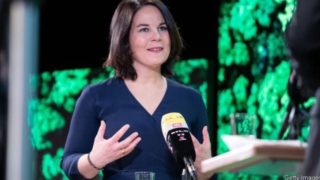POST-WAR GERMAN elections have tended to be polite contests between middle-aged men and, more recently, a middle-aged woman, trotting out worthy but similar centrist policies. The process reached its snooziest last time around, in 2017, when the two main parties went into the campaign having spent the previous four years yoked together in a “grand coalition”. That gave them even less scope to offer competing visions to unenthused voters. This year, happily, things will be different.
For a start, there is a genuine chance that the election, to be held on September 26th, will produce Germany’s (and, almost the world’s) first Green head of government in the form of Annalena Baerbock, a 40-year-old parliamentarian with no ministerial experience but plenty of energy, policy nous and a past as an accomplished trampolinist. In a smooth if opaque operation on April 19th, the Green Party anointed Ms Baerbock, rather than her co-leader, the more experienced but more academic Robert Habeck, as its candidate for chancellor. The party saw that she offered it the best chance in September.
Not so their conservative rivals, the Christian Democratic Union (CDU) and its sister party, Bavaria’s Christian Social Union (CSU). A day later, after a long ill-tempered process that has cruelly exposed divisions within and between the two parties, they agreed that the CDU’s boss, Armin Laschet, should be their standard-bearer, even though voters prefer the CSU’s man by a massive margin. Ms Baerbock could hardly have hoped for a better start. Her party has been running a strong second place in the polls, behind the CDU/CSU.
Voters now face a real choice. The Greens have come a long way from their radical anti-growth fundi (for “fundamentalist”) roots, and have plenty of experience of government. They form part of the ruling coalition in 11 of Germany’s 16 states. Even so, if they won power at the federal level they would pursue a much more ambitious climate policy. They want, for instance, to cut greenhouse-gas emissions by 70% from the 1990 baseline by 2030, rather than the existing target of 55%. They would more than double the level of carbon taxes, set tougher targets for renewables in power generation, and accelerate the closure of Germany’s coal-fired power plants.
In other areas too, the Green programme is a genuine alternative. The Greens will be more receptive to spending money, both at the European level, in the shape of more EU-backed funding for investment in weaker countries, and in Germany itself, where the strictures against deficit financing have resulted in surprisingly creaky infrastructure, especially of the digital variety. The Greens are divided over foreign policy, but may be tougher on Russia and China and less inclined to put trade ahead of human rights.
The CDU/CSU, in contrast, will offer business as usual. But that appeals to many Germans, especially those who fear the Greens are still anti-business. The parties have won the most seats at every federal election since 2005. The cautious, consensus-building Mr Laschet has demonstrated that he is tenacious, even if he lacks the charisma of his CSU rival, Markus Söder.
One way or another, though, Germany’s future looks greener—and Europe’s with it. Even if Ms Baerbock fails to become chancellor, the numbers suggest it will be impossible to construct the next ruling coalition without the Greens. A new grand coalition has been all but ruled out by the Social Democrats, who have seen their popularity plummet as a result of being involved in the past two; the far-right Alternative for Germany remains a political pariah; and the liberal Free Democrats are a marginal force. Ms Baerbock will have a fistful of strong cards to play.
By The Economist





